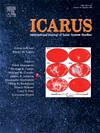The role of pre-existing topography in modulating lunar lava flow widths, depths and channel structure
IF 2.5
2区 物理与天体物理
Q2 ASTRONOMY & ASTROPHYSICS
引用次数: 0
Abstract
Lunar volcanism is one of the most important endogenic processes on the Moon. The final morphology of a lava flow depends on (a) the composition of the magma, which determines its rheology, (b) the effusion rate, controlled by the geometry of the dike transferring the magma to the surface and the overpressure in the magma source, (c) the lava cooling behavior influenced by whether the flow is laminar or turbulent, (d) the total volume of magma erupted, and the topography of the surface onto which the lava flows. Thus, studying the morphology of flows sheds light on their eruption conditions, and has implications for the nature of the magma source region. In this study, we document the effects of topography on a well-preserved Eratosthenian-aged lava flow that most likely originated from the volcanic complex around Euler Crater in Mare Imbrium. We assess how the observations can improve our understanding of previous models of lunar lava flow emplacement and cooling behavior. We find that: 1) the pre-existing topography significantly affected the morphology of the flow; 2) several low wrinkle ridges predating the eruption and controlling the flow path underwent significant tectonic modification after lava emplacement; 3) variations in the extent of lava channel/levee structures along the flow are linked to turbulent/laminar flow modes; 4) the emplacement of the lava flow investigated here was probably completed in about a week, occurring in the very early period of regional wrinkle ridge formation. This lava flow history provides new insight into the interplay of regional volcanism and tectonism in Mare Imbrium and late-stage lunar thermal evolution in general.
Key points
- •The geometric and morphological features of lava flows can be significantly affected by pre-existing topography.
- •The observed channel within a well-preserved Imbrium lava flow is interpreted to imply a transformation of flow mode from turbulent to laminar.
- •We deduced the paleo-geological sequence of processes forming this Imbrium lava flow.
月球火山活动是月球上最重要的内生过程之一。熔岩流的最终形态取决于:(a) 岩浆的成分,这决定了其流变性;(b) 岩浆的喷出速度,这受将岩浆转移到地表的堤坝的几何形状和岩浆源的超压控制;(c) 熔岩的冷却行为,这受熔岩流是层流还是湍流的影响;(d) 岩浆喷发的总体积,以及熔岩流所处地表的地形。因此,研究熔岩流的形态可以了解其喷发条件,并对岩浆源区域的性质产生影响。在这项研究中,我们记录了地形对一个保存完好的埃拉托塞时代熔岩流的影响,该熔岩流很可能源自英布里姆海区欧拉环形山周围的火山群。我们评估了这些观测结果如何能够提高我们对以往月球熔岩流置放和冷却行为模型的理解。我们发现1)先前存在的地形对熔岩流的形态产生了重大影响;2)熔岩喷发前控制熔岩流路径的几条低皱脊在熔岩喷发后经历了重大的构造改变;3)熔岩流沿线的熔岩通道/岩脉结构范围的变化与湍流/层流模式有关;4)本文所研究的熔岩流的喷发可能在大约一周内完成,发生在区域皱脊形成的早期。该熔岩流的历史为了解英布里姆马的区域火山活动和构造运动的相互作用以及整个月球晚期的热演化提供了新的视角。
本文章由计算机程序翻译,如有差异,请以英文原文为准。
求助全文
约1分钟内获得全文
求助全文
来源期刊

Icarus
地学天文-天文与天体物理
CiteScore
6.30
自引率
18.80%
发文量
356
审稿时长
2-4 weeks
期刊介绍:
Icarus is devoted to the publication of original contributions in the field of Solar System studies. Manuscripts reporting the results of new research - observational, experimental, or theoretical - concerning the astronomy, geology, meteorology, physics, chemistry, biology, and other scientific aspects of our Solar System or extrasolar systems are welcome. The journal generally does not publish papers devoted exclusively to the Sun, the Earth, celestial mechanics, meteoritics, or astrophysics. Icarus does not publish papers that provide "improved" versions of Bode''s law, or other numerical relations, without a sound physical basis. Icarus does not publish meeting announcements or general notices. Reviews, historical papers, and manuscripts describing spacecraft instrumentation may be considered, but only with prior approval of the editor. An entire issue of the journal is occasionally devoted to a single subject, usually arising from a conference on the same topic. The language of publication is English. American or British usage is accepted, but not a mixture of these.
 求助内容:
求助内容: 应助结果提醒方式:
应助结果提醒方式:


